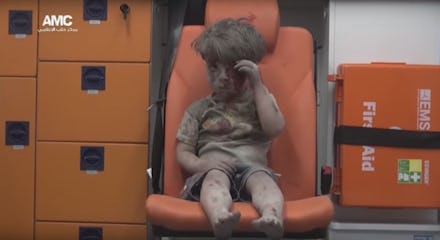You cared about this Syrian boy — but do you care about Syria?

Footage of 5-year-old Omran Daqneesh — who was pulled from rubble after a suspected Russian-backed airstrike on Aleppo, Syria — went viral Thursday. It shows a dazed Daqneesh sitting in an emergency response vehicle, his head covered in blood and his body covered in debris.
But, after the momentary outrage, will the world's reaction to the image have actually done any good?
Stories like this go viral for a reason: People like to feel and appear as though they care about the world's atrocities by disseminating these pictures and associated outrage on social media — and that's not to suggest the reaction is in any way disingenuous.
But the viral focus on a single image, or a single moment, literally and figuratively reduces a wildly complex and layered problem into something two-dimensional.
Politicians — including former GOP presidential candidate Sen. John McCain — and concerned citizens alike participated in the social media frenzy; #OmranDaqneesh soon began trending.
The last of the tweets above references 3-year-old Syrian Alan Kurdi, whose body washed up on a Turkish shore in September after his family attempted to flee Syria on a boat that capsized.
An image of his body on the shore stopped the world in its tracks, producing a reaction similar to that of Daqneesh's footage.
The issue with the widespread comparison of Kurdi and Daqneesh is that people are conflating two disparate problems, applying a blanket label to both: "the horrors of the Syrian civil war." In a macro context: Yes, both incidents were produced by civil war in Syria. But the two children represent vastly different dimensions.
Daqneesh represents Iranian and Russian involvement in Syria: Daqneesh was the victim of airstrikes likely conducted by Russia, a country whose involvement is the subject of a much larger conversation. Russia declares its participation in Syria is to combat ISIS, yet its support of Syrian president Bashar al-Assad (who has fueled the civil war with the use of chemical weapons, for example) appear to have sullied Russia's objectives.
Russian airstrikes "predominantly target moderate Syrian opposition forces," Mark Toner, a State Department spokesman, said Wednesday, according to Al Jazeera. He was responding to Russia's potential violation of a United Nations resolution by using an Iranian airbase to carry out airstrikes over Syria.
And the reasons for Russia and Iran's investment in Syria further complicate matters. Russia remains a massive arms supplier to the Assad regime, with deals worth billions of dollars. Furthermore, supporting Assad is crucial to Russia's objective of mitigating American influence in the Middle East; the U.S. remains staunchly anti-Assad.
The roots of Iran's involvement, however, are found in religious ideology: Iran is a predominantly Shiite country, supporting Assad's Shiite regime. ISIS, conversely, are a Sunni network — an Islamic sect often at odds with Shia Muslims. Geopolitics come into play when you factor Iran's ability to use Syria to access Shiite allies in Lebanon, such as Hezbollah; but that's all dependent on keeping Syria as a Shia ally — in other words, preserving Assad.
Kurdi, on the other hand, represents the global refugee crisis: Kurdi's body was representative of Europe's — and the world's — refugee and migrant calamity. In 2015 alone, over 1 million refugees and migrants fled to Europe. More than one-third of people applying for asylum there were Syrian.
Since the Syrian civil war began in 2011, half of the country, or 11 million people, have been displaced, meaning the influx of refugees and migrants into more secure regions of the world is not likely to abate in the near future. And many risk their lives, dangerously crossing waterways in small, overcrowded boats, just as Kurdi and his family did. More than 300,000 people crossed the Mediterranean Sea in 2015, attempting to seek refuge in Europe.
But the West has yet to develop a comprehensive and sustainable response to this crisis. The United States has made "meager" efforts when it comes to refugee resettlement, David Miliband, president and CEO of the International Rescue Committee, said in September.
In September, the U.S. announced it would accept 10,000 Syrian refugees — that number was deceptive, though, as the 10,000 slots came from part of an existing refugee quota of 75,000; it wasn't for an additional 10,000 people.
Furthermore, America has been particularly slow at following through on its promise, having only accepted 1,736 Syrian refugees by the and of April, the New York Times reported.
Germany has played a substantial role, accepting hundreds of thousands of refugees and migrants. However, recently, it's become part of a highly controversial refugee deal between the European Union and Turkey.
"Large-scale forced returns of refugees from Turkey to war-ravaged Syria expose the fatal flaws in a refugee deal signed between Turkey and the European Union earlier this month," Amnesty International said in a statement on April 1.
Some good has come from these tragic stories being propelled into the international arena. They have galvanized efforts to raise funds for organizations like Doctors Without Borders and the IRC, which are doing crucial work on the ground in Syria.
Yet on a policy level, not much changes in the wake of these widely publicized tragedies, transforming the reaction to these images from one of ostensible altruism to voyeurism. If we collectively refuse to go a step further and truly understand why these children are subjected to such atrocities, we will remain unequipped to demand the change needed to prevent them from happening in the first place.
And if the world's reaction to Daqneesh is anything like our reaction to Kurdi, little will change.